
290 CHAPTER 12. THE CONSTRUCTION OF MEASURES
Proof: Let α ∈ (0,1) and Vα = {x : g(x)> α} so Vα ⊇ K and let h≺Vα .
g > α
VαK
Then h≤ 1 on Vα while gα−1 ≥ 1 on Vα and so gα−1 ≥ h which implies L(gα−1)≥ Lhand that therefore, since L is linear,
Lg≥ αLh.
Since h≺Vα is arbitrary, and K ⊆Vα ,
Lg≥ αµ (Vα)≥ αµ (K) .
Letting α ↑ 1 yields Lg ≥ µ(K). This proves the first part of the lemma. The secondassertion follows from this and Theorem 12.2.7. If K is given, let
K ≺ g≺Ω
and so from what was just shown, µ (K)≤ Lg < ∞. This proves the lemma.
Lemma 12.3.6 If A and B are disjoint compact subsets of Ω, then µ(A∪B)= µ(A)+µ(B).
Proof: By Theorem 12.2.7 or 12.2.8, there exists h ∈Cc (Ω) such that A≺ h≺ BC. LetU1 = h−1(( 1
2 ,1]), V1 = h−1([0, 12 )). Then A⊆U1,B⊆V1 and U1∩V1 = /0.
B V1A U1
From Lemma 12.3.5 µ(A∪B)< ∞ and so there exists an open set, W such that
W ⊇ A∪B, µ (A∪B)+ ε > µ (W ) .
Now let U =U1∩W and V =V1∩W . Then
U ⊇ A, V ⊇ B, U ∩V = /0,and µ(A∪B)+ ε ≥ µ (W )≥ µ(U ∪V ).
Let A≺ f ≺U, B≺ g≺V . Then by Lemma 12.3.5,
µ(A∪B)+ ε ≥ µ(U ∪V )≥ L( f +g) = L f +Lg≥ µ(A)+µ(B).
Since ε > 0 is arbitrary, this proves the lemma.From Lemma 12.3.5 the following lemma is obtained.